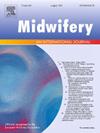The impact of implementing universal screening for antenatal mental health conditions in Southern Tasmania, Australia: A retrospective observational study
IF 2.6
3区 医学
Q1 NURSING
引用次数: 0
Abstract
Problem
The impact of universal screening for perinatal depression on referrals is unknown.
Background
The Australian National Perinatal Depression Initiative (NPDI) implemented in 2008 recommended universal screening of perinatal depression and provision of follow-up support and care when indicated.
Aim
To assess the impact of the implementation of the NPDI in public antenatal care in Southern Tasmania on screening levels and referrals provided to support services for mental health and/or psychosocial concerns.
Methods
Data were derived from a clinical audit of digital records for women who attended public antenatal services and gave birth from July-December 2011 (pre-implementation, n = 911) and 2014 (post-implementation, n = 896). Data included patient demographics and obstetric factors, Edinburgh Postnatal Depression Scale (EPDS) scores, and referrals given.
Findings
Pre-implementation, 1.32 % of women were screened with the EPDS and 95.98 % post-implementation, with 31.17 % and 26.00 % of women referred to support services respectively. Of those referred, referrals were provided at 1.25 visits on average pre-implementation, 1.57 visits post-implementation. Women younger than 20 years and women living in the most disadvantaged locations were more likely to have an EPDS score ≥10. Communication between antenatal care and primary care providers increased.
Discussion
Improved communication between care providers indicates a strengthened continuum of care. The impact of the concurrent introduction of an integrated care model on findings is unclear.
Conclusion
The introduction of the NPDI in Southern Tasmania led to higher screening rates but fewer women referred for support services. The findings support the need for embedded evaluations to ensure timely and informed decision-making.
澳大利亚南塔斯马尼亚州实施产前精神健康状况普遍筛查的影响:一项回顾性观察研究
问题围产期抑郁症的普遍筛查对转诊的影响尚不清楚。2008年实施的澳大利亚国家围产期抑郁症倡议(NPDI)建议对围产期抑郁症进行普遍筛查,并在必要时提供随访支持和护理。目的评估在南塔斯马尼亚州公共产前保健中实施国家产前发展计划对筛查水平和向心理健康和/或社会心理问题支助服务提供转诊的影响。方法数据来源于2011年7月至12月(实施前,n = 911)和2014年(实施后,n = 896)接受公共产前服务并分娩的妇女的数字记录的临床审计。数据包括患者人口统计学和产科因素、爱丁堡产后抑郁量表(EPDS)评分和转诊。实施前,1.32%的妇女接受了EPDS筛查,实施后为95.98%,其中31.17%和26.00%的妇女分别接受了支持服务。在这些转介者中,执行前平均转诊1.25次,执行后平均转诊1.57次。年龄小于20岁的女性和生活在最不利地区的女性更有可能出现EPDS评分≥10的情况。产前保健和初级保健提供者之间的沟通增加了。讨论护理提供者之间沟通的改善表明护理的连续性得到加强。同时引入综合护理模式对结果的影响尚不清楚。结论南塔斯马尼亚州NPDI的引入导致更高的筛查率,但较少的妇女转诊到支持服务。调查结果支持需要进行嵌入式评价,以确保及时和知情的决策。
本文章由计算机程序翻译,如有差异,请以英文原文为准。
求助全文
约1分钟内获得全文
求助全文
来源期刊

Midwifery
医学-护理
CiteScore
4.50
自引率
7.40%
发文量
221
审稿时长
13.4 weeks
期刊介绍:
Midwifery publishes the latest peer reviewed international research to inform the safety, quality, outcomes and experiences of pregnancy, birth and maternity care for childbearing women, their babies and families. The journal’s publications support midwives and maternity care providers to explore and develop their knowledge, skills and attitudes informed by best available evidence.
Midwifery provides an international, interdisciplinary forum for the publication, dissemination and discussion of advances in evidence, controversies and current research, and promotes continuing education through publication of systematic and other scholarly reviews and updates. Midwifery articles cover the cultural, clinical, psycho-social, sociological, epidemiological, education, managerial, workforce, organizational and technological areas of practice in preconception, maternal and infant care.
The journal welcomes the highest quality scholarly research that employs rigorous methodology. Midwifery is a leading international journal in midwifery and maternal health with a current impact factor of 1.861 (© Thomson Reuters Journal Citation Reports 2016) and employs a double-blind peer review process.
 求助内容:
求助内容: 应助结果提醒方式:
应助结果提醒方式:


